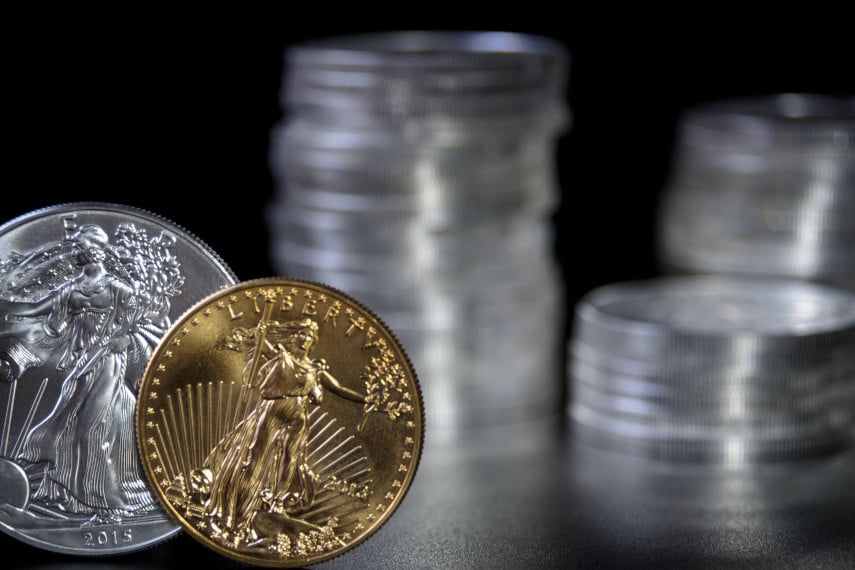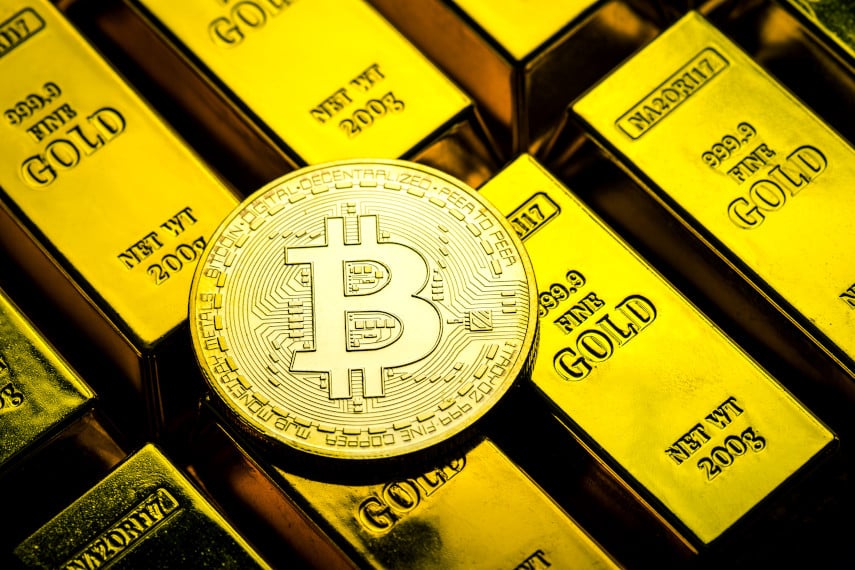
To investors who remember the stock market boom of the 1980s and 1990s, the decision to invest in gold may be an uncomfortable one. Investors who cut their teeth during that time and who remember the phenomenal gains to be made investing in Wall Street may be loath to move their money out of the stocks and bonds with which they’re familiar. But gold is becoming an increasingly popular investment with those investors, as weak economic growth and the prospect of a stock market crash have investors looking for safe assets with which to protect their wealth.
Gold was once looked upon as a relic of the past, something which only gold bugs sought out. Mainstream financial advisers and commentators laughed at the idea of investing in gold, and even those who saw gold’s ability to contribute to a well-diversified investment portfolio, only advised holding percentages in the low single digits. But as the debt- and credit-fueled US economy shows increasing signs of stagnation, gold is once again regaining its popularity as a primary investment asset.
Key Takeaways
-
Gold has served as a store of wealth for millennia
-
Gold has outperformed stock markets over both 20-year and 50-year time horizons
-
Continued economic and stock market weakness will drive up gold’s popularity
History of Gold
While gold may no longer serve as money in the United States, and indeed around the world, that development is merely a minor blip in the thousands of years of monetary history. Even before the development of coinage in the 700s BC, gold ingots and bars had served as money. And while silver may have been the common metal of daily commerce, gold was the metal trusted for large, important transactions, international trade, and wealth accumulation.
The era of the classical gold standard was also short, only lasting from the early 19th century to the First World War, but it coincided with an era of great industrial productivity and commercial growth. The existence of a stable monetary system allowed industry to prosper, helping fuel the Industrial Revolution and a meteoric rise in living standards around the world.
Because the gold standard placed constraints on government spending, governments abandoned gold during World War I. And despite various attempts to get back to the gold standard after the war, the return of the gold standard was never really successful.
Despite that, the post-World War II Bretton Woods monetary system sought to establish a gold exchange standard, in which a gold-backed dollar would form the basis for international trade. But as the US government took advantage of its position to create more dollars than it had gold backing, that system too began to break down. This culminated with President Nixon’s closure of the gold window in 1971, severing the last official link between the dollar and gold.
Nixon’s actions allowed gold to trade freely on world markets, and the gold price soared. US investors were finally allowed to own gold again in 1975, further boosting world demand. And the stagflation of the 1970s led many investors to invest in the yellow metal, which saw tremendous growth throughout the decade. Because investing in gold gained so much popularity, the 1970s and early 1980s saw an explosion of new gold products offered to investors.
But as the Federal Reserve began to tighten its monetary policy and get inflation under control, stock markets began to take off late in 1982. And the stock bull market of the 1980s and 1990s caused many investors to forget about gold, or to treat it as an afterthought. And that is where gold remained in many investors’ minds, until the financial crisis of 2008.
Why Gold Has Been Gaining Popularity Recently
After the long bull run of the 1980s and 1990s, the collapse of the dotcom bubble was a shock to many investors. But buoyed by the monetary response of the Federal Reserve, many shook it off and expected stock markets to return to their booming heyday.
The collapse of the housing bubble a mere eight years later threw investors for another loop. And the losses sustained by many investors were massive. Stock indexes lost nearly 55% of their value, sending them back to levels that hadn’t been seen since the mid-1990s. Years or decades worth of stock market gains were wiped out in months.
The aftermath of the crisis was similarly confusing, as the economy didn’t just bounce back and return to normal. A slow, painful recovery ensued, and the investing environment didn’t give investors many great choices.
Among the best choices was gold, which saw a return to its glory days. While stock markets lost over 50% of their value, gold gained 25% during the same time frame. And in the years following the crisis, gold continued to gain value, nearly tripling in value from its 2008 lows to its 2011 highs. That enormous rise in price caused investing in gold to gain in popularity.
Even investors who had long despised gold began to take notice and to realize the importance that gold could play in a well-diversified investment portfolio. They began to pay more attention to the Federal Reserve, to the conduct of US monetary policy, and to the health and strength of the US dollar. And they began to realize that over the long term, the US dollar and dollar-denominated assets weren’t the best place to invest their money.
These investors realized that gold was no longer a forgotten relic of days gone by, nor was it the underperforming asset of the 1980s and ‘90s. No longer the target of price suppression by central banks and allowed to run free, gold was beginning to reassert itself as a prime long-term investment asset.
Gold as a Long-Term Investment
While gold really only broke into the public’s consciousness in 2008, the reality is that gold had been quietly growing in value ever since the dotcom bubble collapsed. In fact, gold’s average annualized gains since 2001 have been more than double those of stock market indexes such as the Dow Jones Industrial Average and the S&P 500.
With so much attention on stock markets, IPOs, and technology startups, it’s easy to see why gold was overlooked. It’s not flashy, it doesn’t ever become the flavor of the month, it just sits there continuing to gain value. Even though it seems that investing in gold only gained popularity over the past decade, the reality is that this increased popularity has been growing under the surface for almost two decades.
Gold’s ability to protect wealth over the long term isn’t just a recent development either. Since the closing of the gold window, gold has similarly outperformed stock markets, with gold gaining at an average annualized rate of 8.1%, versus 7.3% for the Dow Jones and 7.5% for the S&P 500. For investors looking both to protect their wealth against loss during financial crises and build their wealth over the long term, investing in gold can play an important role in achieving both of those aims.
3 Most Popular Gold Investments
As investing in gold has gained popularity in recent years, that has led to a surge in demand for gold investment products. Here are some of the most popular gold investments on the market today.
1. Gold Coins
There’s just something about holding a gold coin in your hand that tells you that you’re holding real money. Perhaps that’s why gold coins remain one of the most popular gold investments around today.
The types of gold coins available for investment purposes range from collectible Greco-Roman coins to 19th century coins originally intended for commercial trade to 21st century bullion coins produced in mints around the world. The choices are nearly endless, although the types of coins you invest in can be determined by your investment vehicle.
If you’re buying coins to hold at home, you can pick just about any gold coin you want. But if you’re looking to invest in gold through a gold IRA, an increasingly popular gold investment vehicle, you have to make sure that the coins your IRA purchases are eligible for IRA investment.
While most modern gold coins produced in the last 30 or so years are eligible for IRA investment, most coins produced before about the mid-1980s are not eligible. Trying to buy coins that aren’t eligible for IRA investment can result in significant taxes and penalties. Make sure when investing through a gold IRA that the gold coins you’re interested in are IRA-eligible.
2. Gold Bars
Gold bars are another popular means to invest in gold. While few investors have the financial ability to purchase a 400-ounce Good Delivery Bar, bars are available in numerous different sizes. For most retail investors, common sizes can range from as small as 1 gram to as large as 1 kilogram (~32.15 troy ounces).
For gold IRA investors, gold bars are subject to the same guidelines and regulations as gold coins. Most gold bars produced today are eligible for investment through a gold IRA, as they meet the legally required gold fineness.
3. Gold ETFs
Gold exchange-traded funds (ETFs) are another popular way to invest in gold and are gaining market share. ETFs allow investors to gain portfolio exposure to commodities, precious metals, or other assets that otherwise would be too difficult, expensive, or time-consuming for retail investors to purchase. ETFs purchase assets, then issue shares in their fund to investors, with the price of the shares rising and falling based on the value of the underlying assets.
Investing in gold through ETFs, however, has a number of drawbacks, not the least of which is knowing where the gold held by the ETF actually is. Due to custodial and subcustodial relationships, actual ownership and physical possession of a fund’s gold isn’t always known. And as an ETF investor, you can’t actually convert your shares to gold. Couple that with management fees and listing fees, and gold ETFs often aren’t the best way to invest in gold. If you want to really benefit from owning gold, then investing in physical gold coins and bars that you actually own and control can be a far better choice.
Don’t Miss Out on a Popular Investment
Because of the rising popularity of investing in gold, along with diminishing supplies from mints that are having to adjust production schedules to address concerns surrounding COVID, the next few months could see some real supply shortages, which could put strong upward pressure on the gold price. If you’re interested in investing in gold to protect your investments, now’s the time to do it.
The experts at Goldco have years of experience helping thousands of investors like you benefit from investing in gold. Whether you want to learn more about setting up a gold IRA, explore your options for investing in physical gold, or figure out whether you can roll over your existing retirement assets into a gold investment, the experts at Goldco can answer all your questions. Contact Goldco today to find out how you can take advantage of the rising popularity of gold to benefit your investments.






